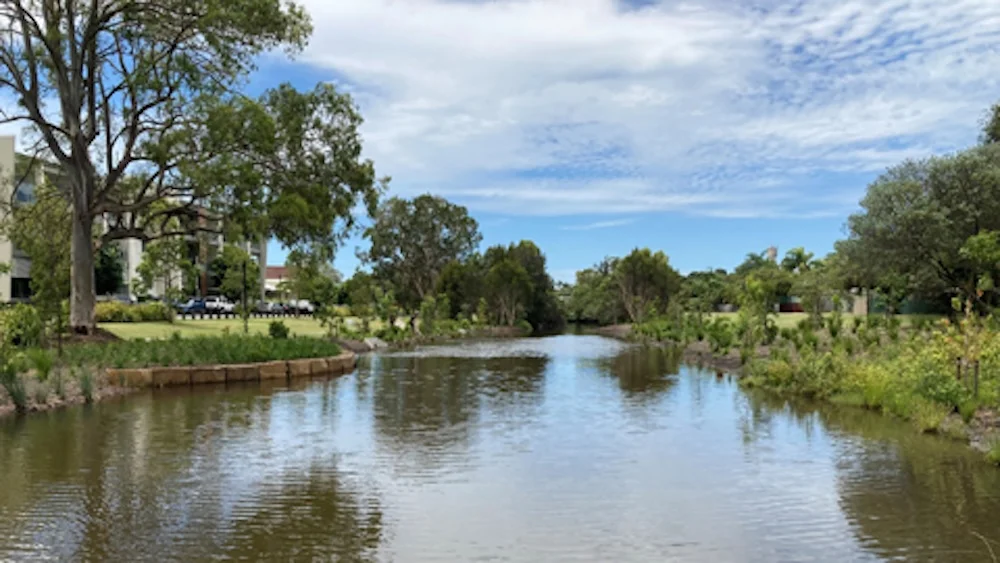Bells Creek: An Urban Waterway Linking Suburbs and Bay
Running through the suburbs of Clontarf and Margate, Bells Creek flows from Maine Road toward Bramble Bay, carrying urban runoff from nearby streets into the bay. The City of Moreton Bay describes Bells Creek as an “important multi-use drainage corridor” that has been heavily modified over time to manage stormwater for the surrounding suburbs. Although relatively small, the creek provides aquatic habitat and a place where residents can experience the natural environment close to home.
A Connected Estuary
Near the Deception Bay Declared Fish Habitat Area (FHA-013), a 1,490-hectare estuarine zone with mangrove woodlands, saltmarsh and intertidal flats, Bells Creek forms part of the network of waterways feeding into the bay. Within this wider system, mangrove-lined creeks and flats support juvenile bream, flathead, whiting, prawns and crabs before they move into open waters. These nursery habitats are vital to both local ecology and recreational fishing across the region.
For residents who fish or crab nearby, waterways like Bells Creek provide more than scenery. They are places to spend weekends outdoors, teach children to fish and connect with the tides and mangroves that shape the Moreton Bay coastline.
Recreation Close to Home
Council documents identify Bells Creek in Clontarf as a site for fishing, boating, kayaking and birdwatching, showing its value as a local recreation area. The mangrove-lined channel sits within easy reach of Redcliffe Peninsula suburbs and is suited to low-impact activities such as paddling and nature observation. The estuary’s mudflats and mangrove edges also provide feeding habitat for shorebirds and small marine life, making it both a wildlife corridor and a place for quiet recreation.
Improving Water Quality
In 2018, the City of Moreton Bay investigated sites within the Bells Creek catchment as part of its Total Water Cycle Management (TWCM) program. The aim was to retrofit stormwater systems to reduce sediment and nutrient runoff into the creek. In Stage 1 of the project, about 120 metres of concrete-lined channel were replaced with a sedimentation pond, bioretention basin and native riparian vegetation. The works are expected to improve water quality and aquatic habitat, create more natural-looking banks and provide better pedestrian access along the corridor.
These efforts reflect a wider shift in how councils across South-East Queensland manage urban waterways — treating them not just as drains, but as natural assets that contribute to liveability, biodiversity and local recreation.

Environmental Pressures
Urban runoff and sediment from surrounding suburbs, together with broader development in the catchment, are recognised pressures on waterways like Bells Creek. A Moreton Bay Foundation study found that between 2000 and 2018, several of the region’s major estuaries showed improved water quality, but population growth and land development remain major challenges.
Through its TWCM planning, the City of Moreton Bay identified Bells Creek for water-quality improvements to help address those pressures. The Deception Bay FHA designation also provides safeguards under State Code 12, which requires development in declared Fish Habitat Areas to avoid or minimise impacts on fish-habitat values and, where possible, maintain community access to fisheries resources.
Looking Ahead
As suburbs along the bay continue to grow and become more connected, Bells Creek remains one of the links between residential streets and the tidal waters of Bramble Bay. Planning and research documents highlight its ecological importance and its use for recreation and fishing. Council’s ongoing works and regional programs aim to keep the creek functioning as a healthy, accessible waterway into the future — a small but significant part of everyday coastal life in the Moreton Bay Region.


